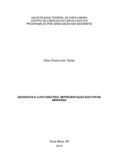| dc.creator | Guites, Airton Rosa Lucion | |
| dc.date.accessioned | 2020-03-13T20:17:10Z | |
| dc.date.available | 2020-03-13T20:17:10Z | |
| dc.date.issued | 2019-12-13 | |
| dc.identifier.uri | http://repositorio.ufsm.br/handle/1/19848 | |
| dc.description.abstract | The Brazil is a plural nation, formed through the mixing of differents ethnicities, among which there are indigenous people. Geography, being a science dedicated to studying the relationship between society and nature, must analyze the indigenous question from the perspective of territoriality, space organization and social participation as political agents. The indigenous people went through different stages in the historiography of the country, but a characteristic always present was the acculturation process imposed by the European colonizer that stayed in the implied sense even after the Independence. For Geography understands the articulations of indigenous people in the Brazilian territory of the 21st century, it is imperative to refer back to the past, understanding how the indigenous participated in the formation of Brazil at the same time as they were "erased" by the ethnic transfiguration. Under the bias of education, the Geography as a school discipline has the duty to consider the issue of indigenous people, although this does not always happen in a satisfactory way. Through teaching materials, such as textbooks, the geography is embedded in the educational field and offer students the development of the ability to observe, interpret and reflect reality. Although there are many methodological critiques about textbooks, they still are the materials of increased access and dissemination in Brazilian schools. Thus, we have the theme of this research, which is the representation of indigenous people in Geography textbooks. The problem that will guide the research will be: the textbooks of Geography represent the indigenous as social and political agent of space? In order to answer this question, was analyzed and investigated, by specific criteria, the way indigenous people are approached by Geography in books of this segment for several decades. Therefore, teachers from Santa Maria/RS were interviewed to understand their view about this subject. As a result, the textbooks were divided into three periods, which presented a methodological evolution about the indigenous approach, but that still has many aspects to improve. Regarding teachers, it was noticed that there was no focus on the theme throughout their academic education, which impairs their teaching performance. | eng |
| dc.language | por | por |
| dc.publisher | Universidade Federal de Santa Maria | por |
| dc.rights | Attribution-NonCommercial-NoDerivatives 4.0 International | * |
| dc.rights.uri | http://creativecommons.org/licenses/by-nc-nd/4.0/ | * |
| dc.subject | Geografia | por |
| dc.subject | Indígenas | por |
| dc.subject | Livro didático | por |
| dc.subject | Educação | por |
| dc.subject | Ensino | por |
| dc.subject | Geography | eng |
| dc.subject | Indigenous people | eng |
| dc.subject | Textbook | eng |
| dc.subject | Education | eng |
| dc.subject | Teaching | eng |
| dc.title | Geografia e livro didático: representação dos povos indígenas | por |
| dc.title.alternative | Geography and textbook: representation of indigenous peoples | eng |
| dc.type | Dissertação | por |
| dc.description.resumo | O Brasil é uma nação plural, formada através da miscigenação de diversas etnias, dentre as quais há os povos indígenas. A Geografia, sendo uma ciência que se dedica a estudar a relação entre a sociedade e a natureza, deve analisar a questão indígena pela ótica da territorialidade, da organização espacial e da participação social enquanto agentes políticos. Os indígenas passaram por etapas distintas na historiografia do país, mas uma característica sempre presente foi o processo de aculturação imposto pelo colonizador europeu e que se manteve nas entrelinhas mesmo após a Independência. Para a Geografia entender as articulações dos povos indígenas no território brasileiro do século XXI, é imprescindível reportarmo-nos ao passado, entendendo como os indígenas participaram da formação do Brasil ao mesmo tempo em que foram “apagados” pela transfiguração étnica. Sob o viés da educação, a Geografia enquanto disciplina escolar tem o dever de abordar os povos indígenas, embora nem sempre isso aconteça de forma satisfatória. Através de materiais de ensino, como os livros didáticos, a Geografia insere-se no campo educacional e oferta aos alunos o desenvolvimento da capacidade de observar, interpretar e refletir a realidade. Apesar de haver muitas críticas metodológicas sobre os livros didáticos, eles ainda são os materiais de maior acesso e disseminação nas escolas brasileiras. Sendo assim, tem-se o tema desta pesquisa, que é a representação dos povos indígenas nos livros didáticos de Geografia. A problemática que norteará a pesquisa será: os livros didáticos de Geografia representam os indígenas como agente social e político do espaço? A fim de solucionar tal problema, foi analisado e investigado, por meio de critérios específicos, a forma como os indígenas são abordados pela Geografia em obras desse segmento por várias décadas. Por conseguinte, foram entrevistados professores de Santa Maria/RS a fim de entender qual sua visão a respeito deste assunto. Como resultados, os livros didáticos foram divididos em três períodos, em que apresentaram uma evolução metodológica sobre a abordagem dos indígenas, mas ainda possuem muitos aspectos a melhorar. Com relação aos professores, percebeu-se que não houve enfoque da temática ao longo de sua formação acadêmica, o que prejudica na atuação docente. | por |
| dc.contributor.advisor1 | Cardoso, Eduardo Schiavone | |
| dc.contributor.advisor1Lattes | http://lattes.cnpq.br/6467146489705005 | por |
| dc.contributor.referee1 | Benaduce, Gilda Maria Cabral | |
| dc.contributor.referee1Lattes | http://lattes.cnpq.br/0879049524486787 | por |
| dc.contributor.referee2 | Rocha, Aristeu Castilhos da | |
| dc.contributor.referee2Lattes | http://lattes.cnpq.br/3178211577215938 | por |
| dc.creator.Lattes | http://lattes.cnpq.br/2593510584005210 | por |
| dc.publisher.country | Brasil | por |
| dc.publisher.department | Geografia | por |
| dc.publisher.initials | UFSM | por |
| dc.publisher.program | Programa de Pós-Graduação em Geografia | por |
| dc.subject.cnpq | CNPQ::CIENCIAS HUMANAS::GEOGRAFIA | por |
| dc.publisher.unidade | Centro de Ciências Naturais e Exatas | por |



